Does Mobile Ad Sizes really matter?

With an estimated 5 billion mobile users on the planet, engagement with mobile devices is higher than ever and continuously growing.
People of all ages, generations, and genders are using their devices wherever they go, some for even for hours per day. These users get bombarded by messages, news events, and social media on a daily basis – all very distracting.
This increases the need for mobile ads to be attention-grabbing, placed in optimal digital spots for maximum viewability while utilizing the best banner sizes for maximum revenue generation for publishers and successful campaign management for advertisers.
Let’s take a look at some of the best mobile ad sizes for publishers in 2023 and optimization tips you can start implementing today:
- The 300×250 ad unit
- 320×50, 300×50, and 300×100 are to become more popular in 2023.
- 36×280 & 320×480 will be the rising stars.
- Web interstitials or full-page web ads.
- Plus optimizations tips.
|
Running into costly errors with mobile ad ops? It’s overwhelming to learn the various techniques to start winning with mobile ads. That’s where we can help. Partner with MonetizeMore today to take on the mobile web and start increasing your mobile ad revenue today! |
The 300×250 ad unit
Since the last 5 years, when Google changed their mobile ad types policies and removed restrictions to place 300×250 units above the fold, this medium rectangle has been the most used banner size. It works very well on both desktop and mobile, which is one of the main reasons for its popularity.
It also performs very well because it is usually embedded within the content of the website. The image below demonstrates viewability compared to ad placement of the 300×250 unit.
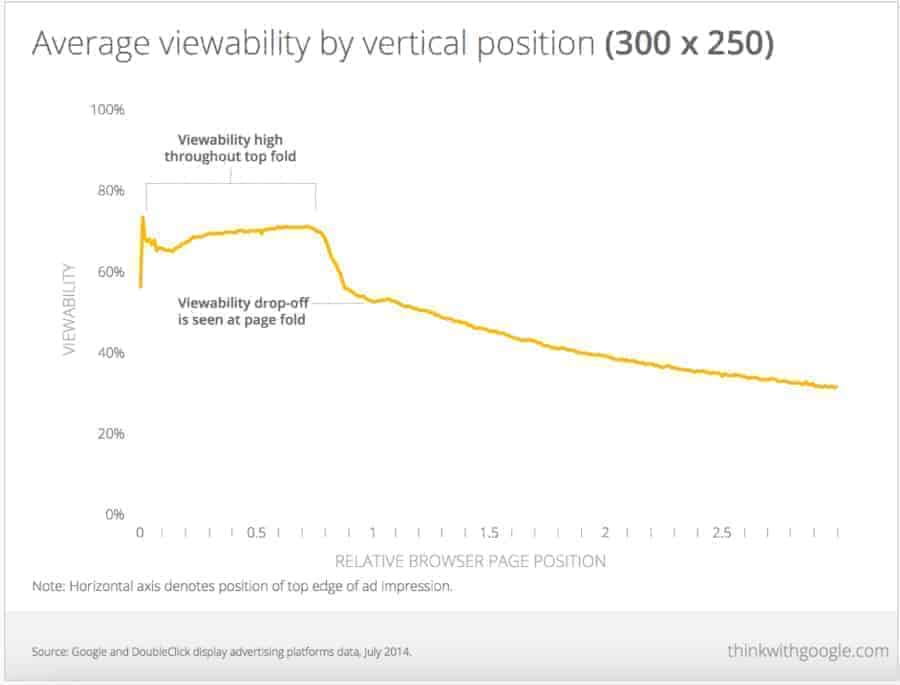
Buyers tend to favor this placement as it is the first thing users see on a mobile site’s landing page. Compared to the small banner sizes (e.g., 320×50), bigger mobile display ad sizes (e.g., 300×250) usually generate better revenues.
However, being too aggressive with your ad placements can increase the chances of accidental clicks and lead to negative user experiences. As a publisher reliant on one of Google’s networks for monetization, whether it’s Ad Exchange or AdSense, you don’t want to risk getting your account banned.
For this reason, it’s best to follow Google recommendations and only have 50% of the ad viewable above the fold. The image below provides excellent examples of successful 300×250 as well as 300×50 mobile ad specs and placements.
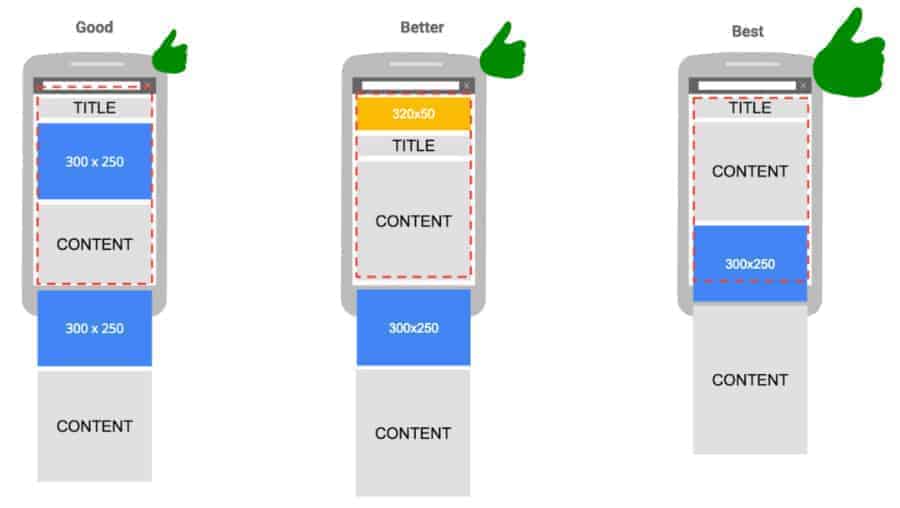
More mobile ad unit sizes to consider
Larger advertising formats (e.g., mobile interstitial ad sizes) have been proven to be better at capturing the user’s attention and paying the best CPM rates, but publishers should be careful with intrusive ad formats in 2022 on both mobile and desktop versions of their sites.
There’s a non-stop search for creative ways to deliver ads on mobile, thus the birth of these large ad formats which up to now, continues to grow.
In a recent study from Adpiler, 320×50 mobile ad size was found to be the most popular ad size for mobile. 27% of all ad impressions is this medium banner. Although small, it works very well as an Anchor Ad.
The formats 320×50, 300×50, and 300×100 are to become more popular in 2023. But don’t forget the value of the 300×250 banner for your mobile coverage.
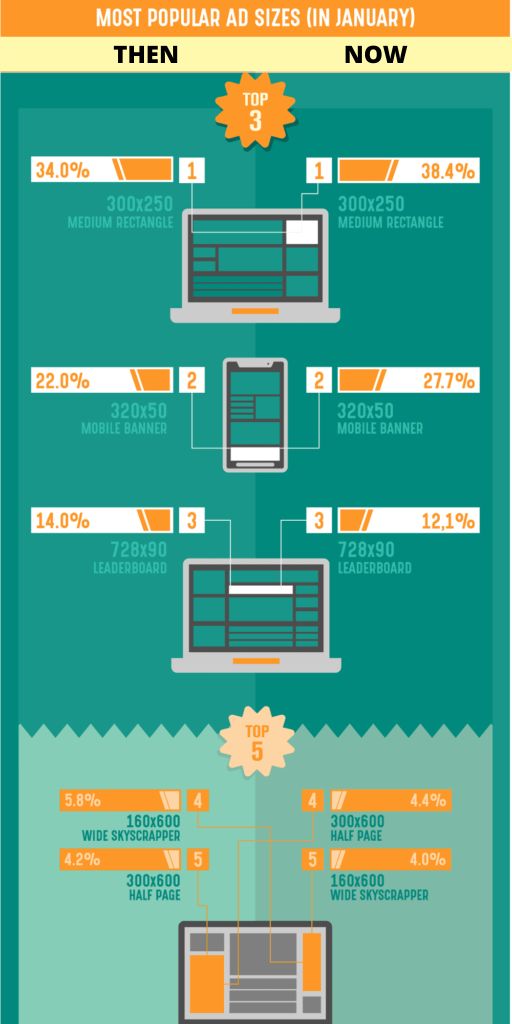
In 2023, 36×280 & 320×480 will be the rising stars, that’s because of the recent launch of Web Interstitials from Google which supports these 3 sizes: 300×250, 320×480, 336×280.
Mobile Banner Ads & Tips to use them
Mobile banner ads are a staple of the mobile ad ecosystem. They’re omnipresent on the mobile web, and you’ve likely seen them in your app, too. They’re not going anywhere anytime soon, so it’s important to understand how they work, how they can fit into your marketing strategy, and how to avoid common pitfalls.
One of the most important things to keep in mind about mobile banner ads is that, just like their desktop counterparts, they’re only effective if you make sure the user actually notices them! This means putting them in the right place at the right time. An ad that shows up at prime time won’t do any good if your user is already paying attention to something else on their screen, such as a game or an email.
When it comes to choosing the perfect spot for the mobile banner ad on your website, you must be careful. You don’t want to put it in an area your readers are likely to skip over—on the bottom of a page or after the last article on the page—because they’re likely to not notice it there. Instead, put it in a highly visible spot that people are sure to see as they scroll down your page. This way, even if they don’t click on it right away, they’ll remember seeing it later and will probably visit your site again because they’re curious to see what’s under that ad.
Pros:
- More attention, brand awareness and engagement.
- Decent viewability
- Customized targeting and retargeting options available to improve CTRs
Cons:
- Invalid Traffic
- Banner Blindness
- Accidental clicks inflating a fake high click through rate. This will only cause more revenue clawbacks.
Mobile Native Ads
Mobile native ads that come with the ‘promoted/recommended or suggested’ tag are preferred by many publishers since they are non-intrusive and is not supposed to look sales-oriented. These ads work well for publishers with high pageviews.
They blend well with the content theme and style, so users are not annoyed by these type of mobile ads. Combine them with rewarded ads and interstitial ads for best results.
Pros:
- Seamless flow and non-interruptive user experience.
- Better performance compared to banner ads.
- Automatically adjusts its size & look based on the user’s device.
- Unaffected by ad blockers.
Cons:
- Expensive
- Needs to be implemented properly.
Maximize Revenue with Mobile Video Ads
- Keep optimizing your mobile ad inventory to attract high paying advertisers
- Use both instream and outstream mobile video ads for more engagement
- Keep your mobile video ads 15-30 seconds to attract attention and conversions.
Interstitial Ads
Ever seen those rich media or video ads on Snapchat that cover the whole screen either annoying the viewer or embarking their interest in the ad? These extreme ads are interstitials and are usually placed between story or game transitions. Other than that, these ads have high viewability and have the potential of attracting higher CTRs if placed the right way.
Users may find these ads intrusive, so taking care of Interstitial ads when displaying them is crucial:
- User experience needs to be prioritized here so place them between natural transitions only.
- There should always be a close button for this ad. No one should be forced to watch the whole ad.
- Follow Google’s guidelines for interstitials and use an invalid traffic/IVT solution to block accidental clicks.
Understand how to implement them here:
Optimization Tips

1) The mobile banner 320×50 is best implemented as a docked/anchor unit. That’s when it performs better regarding CTR. Since it’s a small ad unit, when served as a regular banner, 300×250 and 320×100 units usually outperform it.
2) “Scroller,” an emerging ad unit that fills the screen without covering the entire content is one approach to ad-blocking concerns. According to the IAB’s report, this type of ad format is non-invasive (the users can scroll past them) and has outperformed expandable banners regarding creativity and enjoyment.
3) Medium Rectangle (300×250) remains to be the best performing banner size. Take advantage of the opportunity to implement it above the fold.
4) In-banner Video (IBV) providers favor 300×250 most of the time. They usually pay the best CPMs which you can compete against Header Bidding to push performance up. When running IBV, try to limit it to two units at most to avoid slowing down the page.
Be careful not to overwhelm your users with too many interstitials per user session. It may turn them off, and they may avoid your site altogether in the future. Should you decide to try interstitials or other intrusive ads, remember the guidelines on the Ad Experience Report.
5) The “Large Rectangle” (336×280) is also a top performing ad size as suggested by Google. Make your ad unit flexi by adding it along with your standard mobile ad sizes (e.g., 300×250 / 336×280). It has been proven to perform well when embedded within text content or at the end of articles.
6) Aside from the ad size, one advantageous feature of mobile devices is the location service plus. This makes advertising more relevant to users and potentially generate higher clicks. If you are using an ad server, like Google Ad Manager, geographical targeting will play a significant role. Most ad networks can specify the countries where they have campaigns available.
7) Check your ads for aesthetics. Keep only those ad networks that serve high definition quality creatives and ditch the pixelated ones regardless of the CPM’s they promise. You can’t afford to compromise on user experience. Ads that are non-pixelated tend to yield positive engagement rates and leave a positive impression on users.
8) You can have multiple ad sizes compete in the same ad spot to tighten competition. For instance, you can have a 300×250 spot serve 320×100 and 320×50. When this happens, the smaller advertisements will always align vertically at the top.
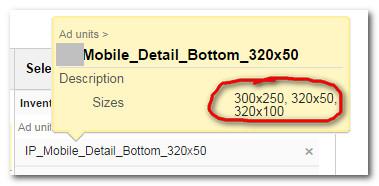
9) Get the best deals on Ad Networks. Several ad networks are offering flat-rate CPMs for interstitials and other mobile ad sizes. At MonetizeMore, we have demand partners who can provide as much as $10 CPM for mobile slider ads, interstitials, anchor units, etc.
Read more mobile optimization tips from Google here.
Stop doing this with Mobile Banner Ads
Mobile banner ads are more than just advertisements: they’re opportunities for you to build meaningful relationships with your users.
Stop doing the following in order to help ensure a positive user experience:
Confusing Banners
Confusing mobile ads will only make users get adblockers and drive more uninstalls. Make sure that your ads are specific and to the point.
Too generic
Your mobile ads need to be more personalized if you want to connect with your users. You can serve mobile ads relevant to your audience if you pay close attention to their location, age, gender, and interests.
Messed up Ad Placements
Ad placement is an art, that, when perfected, can do wonders for both advertisers and publishers in terms of building a brand’s image and maximizing ROI.
Despite low-cost advertising inventory’s appeal at first, poorly targeted ad placements, low-quality inventory, and ad clutter will only burn publishers’ revenue.
Talk to us for the best ad implementation in your site’s sweetest spots!
Click-Bait Ads
Click baiting can definitely drive lots of clicks but ultimately end up causing high bounce rates since the ad was nothing the user was looking for. Even though these ads usually guarantee some level of engagement, their long-term results don’t add up and can negatively affect the publisher’s reputation.
Make sure that your mobile ads are more transparent and does what it claims for better user retention.
Takeaways
The chart below summarizes the best mobile banner sizes you’ll need to be using this year:
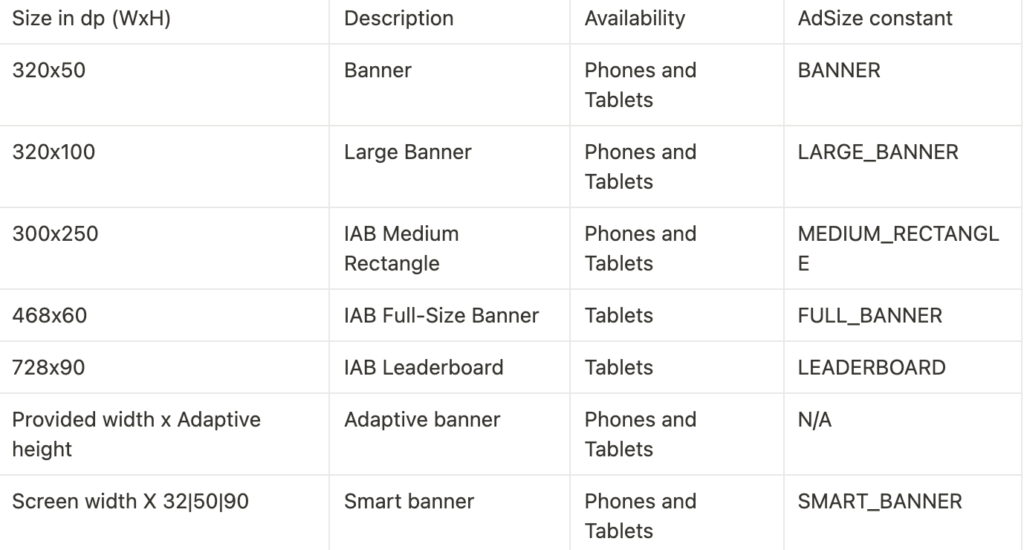
Don’t know where to start with your mobile inventory? Made one too many costly errors already? Partner with MonetizeMore and we will help you navigate the complex landscape of mobile ad optimization to make sure your ad revenue grows in the right direction. Sign up for a Starter account at MonetizeMore today!
Additional FAQ
What are mobile ad sizes?
Mobile ad sizes are ads designed to fit on a mobile or tablet device. Some popular ad sizes for mobile include 300x250, 320x50 and 320x100.
How do responsive display ads work?
Responsive ads adjust their sizes automatically to fit the user's screen, whether they are using a desktop or mobile device.
What size is a leaderboard ad?
A leaderboard ad is a 728x90 ad that is often placed above the fold on tablet and desktop devices where it performs the best.
How big is a 300x250 ad?
A 300x250 ad can take up almost half the screen on mobile devices and is 300 pixels wide and 250 pixels in height.
How Much Do Mobile Banner Ads Make?
Mobile banner ads will make between $0.5-$1.5 per 1000 impressions. When it comes to PPC, the average pay per click is around $0.05. They are used quite often along with rewarded ads and interstitals in many in-app advertising campaigns.
Do Mobile Banner Ads Increase Sales?
Mobile banner ads can 2X sales when used along with mobile video ads, rewarded ads and interstitial ads.
Related Reads:
- Tips in Optimizing Mobile Ads in DFP Small Business
- Best Mobile Ad Optimization Strategies
- Best Ad Optimization Strategies for Tablet Device
- Tips in Optimizing Different Ad Types
- Use 320×100 Mobile Ad Dimensions To Get Better CTRs.
- A user-friendly site is an Adsense-friendly site.
- How to Improve CPMs for Display Ads
source https://www.monetizemore.com/blog/best-mobile-ad-sizes/





0 Comments